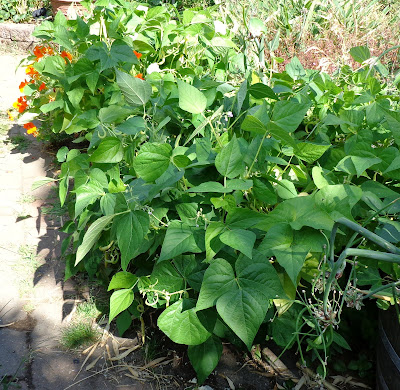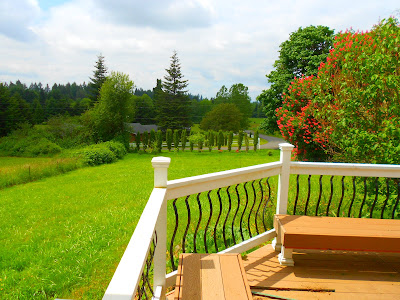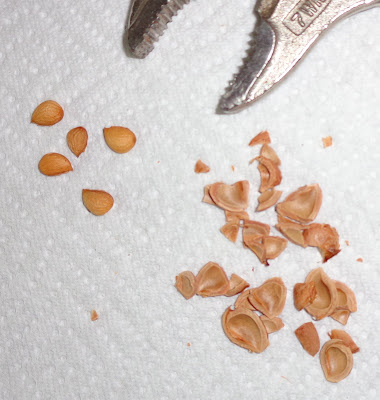Saturday, July 28, 2012
First fig of the year.
The prize goes to Lattarula. I had one yesterday but it was slightly spoiled on the tree. So the is the first really good fig. At 72 grams it's a fair sized fig, nice and juicy and sweet.
I also planted 3 little fig plants at the new place in Battleground. More on that later. The soil is a little better than it was originally here in Vancouver, but not much. Plus, it's mid summer, hot, dry. As potted fig plants, they should have less transplant shock than one dug out of the ground. I planted 2 King figs, each about a foot tall, and one Petite negri, which I've been growing for about 4 or 5 years and has a fair number of small figs on its branches. With lots of water and lots of mulch, maybe they will do OK. One year I left a potted Petite negri fig plant sitting on the deck without water for about 2 months, and it survived.
Thursday, July 19, 2012
Beans are ready
These are the beans I planted in tubs April 14, so roughly 90 days from seed to bean.
There are lots more beans on the plants, ready or barely formed.
The beans themselves aren't visible until you get right into the plant.
Wednesday, July 18, 2012
Iris Order
Order came from Schreiner's Irises. I don't usually "endorse" a source or product. This blog is just my garden diary. But this is different. The rhizomes from Schreiner's were the best I've ever bought. They were carefully packed in excelsior. The tubers were beyond plump - they were like elephant iris. The were clean, healthy, and the leaves were green. I'm so impressed. They also sent two "bonus" tubers, varieties I didn't order. The bonus tubers were just as beautiful as the ones I bought. Schreiners is at schreinersgardens.com.
No room for other additional varieties in the yard now. I had to dig out the patch of Bumblebee Delite, pull out the weeds, and install a weed border as I did for the others, for one and for a couple of rhizimes from Bumblebee Delite, and the found Iris I previously labeled Rescue Me but that isn't really a variety.
These are the varieties I'm planting. The pics are from the Schreiner's online catalog.
I hope they don't mind, especially since I just gave them a AAA rating.
Pink Bubbles.
Redondo.
Mariposa Skies.
Crimson Cloud.
Gay Parosol.
Tuesday, July 17, 2012
Garlic from seeds
I've been reading several internet postings on growing garlic from seeds. As far as I can tell, this isn't currently done except in research and by some dedicated hobbyists. Garlic plants have been cultivated from cloves for eons - probably in a continuous string of generations (clones) dating back thousands of years. As a result, they have nearly lost their capacity to make seeds. Some don't even make flower stalks (scapes). Those that make flower stalks/scapes are the "hard neck". In the ones that do make scapes, much or all of the flower head is replaced by tiny baby garlic bulbs (bulbils) instead of flowers. Those bulbs can be grown into plants, but they are genetic clones of the parent plant. It turns out that there actually are flowers, but they form more slowly than the bulbils, and are crowded out and die before blooming.
Getting garlic to make flowers involves removing the bulbils before they take over the room and resources of the scape. The covering is split open, and twezers are used to remove bulbils as soon as possible.
Removing the covering from this scape, it looks to me like these are flowers. The bulbils must not be formed yet. I will leave it in place, and wait for the other 3 plants whose scapes I inadvertently left in place.
This may not work at all. I've never done it. Gardening is always an experiment.
The potential advantages of seed are many. In the millenia of cloning, genetic diversity is lost. There is some mutation and adaptation via rogueing, because sports also form. But overall, the genetic diversity is decreased, and the ability to adapt more quickly to environmental challenges or growth in new areas, becomes decreased. In addition, if seeds can be formed, so can hybrids. Hybrids give us more choices, and increase potential adaptation and development of variety, such as larger bulbs, or growing faster. Again, based on reading multiple articles, once a new generation of garlic is produced by seeds, subsequent generations are easier to produce. Finally, it's mentioned that viruses are passed through cloning, but not through seed production. I've seen that said for other plants too. I don't know if garlic varieties are virus infected - probably not as bad as with plants that are grafted (fruits, roses) or have long lives (figs), but it's been proposed that producing virus free seed-produced plants would mean more vigor and higher production.
This may not work at all. I've never done it. Gardening is always an experiment.
The potential advantages of seed are many. In the millenia of cloning, genetic diversity is lost. There is some mutation and adaptation via rogueing, because sports also form. But overall, the genetic diversity is decreased, and the ability to adapt more quickly to environmental challenges or growth in new areas, becomes decreased. In addition, if seeds can be formed, so can hybrids. Hybrids give us more choices, and increase potential adaptation and development of variety, such as larger bulbs, or growing faster. Again, based on reading multiple articles, once a new generation of garlic is produced by seeds, subsequent generations are easier to produce. Finally, it's mentioned that viruses are passed through cloning, but not through seed production. I've seen that said for other plants too. I don't know if garlic varieties are virus infected - probably not as bad as with plants that are grafted (fruits, roses) or have long lives (figs), but it's been proposed that producing virus free seed-produced plants would mean more vigor and higher production.
Monday, July 16, 2012
Paw Paw Trees
Here are the 2 containerized Paw Paw trees I bought yesterday at Portland Nursery. When I walked past them I thought No! Impossible! They are the named varieties, Sunflower and NC-1. Based on my readings, the roots are delicate. The trees are best planted while in growth, not dormant. It is best to shade them for the first 1 to 2 years. I'll have to identify a spot, clear it, enrich it with compost, and plant them. Not sue if I'll do that now or just keep them in the containers and plant next Spring.
Sunday, July 15, 2012
Room to expand
This weekend we bought 2 acres in Battleground Washington, close to Vancouver. It will give us room to spread out. Currently it's all in a "before" state. Lots of room to plant and grow. Doubtless in need of a lot of compost too.
 View from the driveway and side street, looking Southeast. I don't see that there's been an attempt at gardening, beyond a few shrubs and trees. The blooming tree is a red buckeye.
These photos were from late May. It's not as green now. This is the view looking North, from the main street.
View from the driveway and side street, looking Southeast. I don't see that there's been an attempt at gardening, beyond a few shrubs and trees. The blooming tree is a red buckeye.
These photos were from late May. It's not as green now. This is the view looking North, from the main street.
 View from the driveway and side street, looking Southeast. I don't see that there's been an attempt at gardening, beyond a few shrubs and trees. The blooming tree is a red buckeye.
View from the driveway and side street, looking Southeast. I don't see that there's been an attempt at gardening, beyond a few shrubs and trees. The blooming tree is a red buckeye.
Labels:
Battleground,
before pictures,
Homestead,
Minifarm,
Room to expand
Saturday, July 14, 2012
Allium gigantium
Decided to dig these up. The cluster was nice, but I would like to have them spread around the garden some more. Allium gigantium makes a brief, very colorful show. Then the leaves die down and that's all for the year. This bunch consisted of one bulb, planted about 5 years ago. Now there are multiple. It's a very rich corner of the garden, lots of compost over the years. No surprise they've done well.
I will let these dry out until it's time to plant fall bulbs. They will be in the basement, cool and dry, stored same as onions. I'm impressed with the size, and number of bulbs. Also some little new starts, for future big bulbs.
Making Hybrid Iris, Iris update
An update on the seed pods. They continue to swell. Now the color is becoming more pale, starting to brown. I take that as a sign if imminent maturity.
 I walk past this every day. I water it occasionally so that it won't dry out. The original rhizomes are growing a bit as well. The pine cones are an impromptu mulch additive. I collect them when walking the dogs and throw them around on the mulch. They add interest, and eventually break down like the rest of the bark chips. They dont seem to cause a problem to the irises.
I walk past this every day. I water it occasionally so that it won't dry out. The original rhizomes are growing a bit as well. The pine cones are an impromptu mulch additive. I collect them when walking the dogs and throw them around on the mulch. They add interest, and eventually break down like the rest of the bark chips. They dont seem to cause a problem to the irises.
The edging rings are working well for keeping weeds out. I still go in and groom the soil a bit. I pull weeds as soon as they are visible. Irises that I have not dug up and transferred to the new little beds are more weedy. This is easier to maintain. Since I've watered these to get them established, they are growing more leaves. I may stop watering them next month, so they can harden off for winter. Some of these are miniatures that I rescued from a bed so covered with grass the plants were not visible, and most died off. I'm glad they are growing again.
These rings are slightly raised above the surrounding area, to improve drainage. They dry out quickly, which is what I want this winter.
 I walk past this every day. I water it occasionally so that it won't dry out. The original rhizomes are growing a bit as well. The pine cones are an impromptu mulch additive. I collect them when walking the dogs and throw them around on the mulch. They add interest, and eventually break down like the rest of the bark chips. They dont seem to cause a problem to the irises.
I walk past this every day. I water it occasionally so that it won't dry out. The original rhizomes are growing a bit as well. The pine cones are an impromptu mulch additive. I collect them when walking the dogs and throw them around on the mulch. They add interest, and eventually break down like the rest of the bark chips. They dont seem to cause a problem to the irises.The edging rings are working well for keeping weeds out. I still go in and groom the soil a bit. I pull weeds as soon as they are visible. Irises that I have not dug up and transferred to the new little beds are more weedy. This is easier to maintain. Since I've watered these to get them established, they are growing more leaves. I may stop watering them next month, so they can harden off for winter. Some of these are miniatures that I rescued from a bed so covered with grass the plants were not visible, and most died off. I'm glad they are growing again.
These rings are slightly raised above the surrounding area, to improve drainage. They dry out quickly, which is what I want this winter.
Sunday, July 08, 2012
Plums From Seed, part 2.
There are many conflicting versions regarding how to sprout wild plum, and other stone fruit seeds. I have a pretty good supply, from collecting plums. They have been washed and allowed to dry. Most are in an envelope after being allowed to dry overnight. Based on several you-tube videos, I chose 5 pits for removal of the hull. I used a vice grip so I could adjust the force, and because I don't have a nutcracker.
Vice grip and plum pits, dried overnight. These are wild plums. The pits are the size of a sweet cherry seed.
The first pit flew across the room. I used a little more finesse for the others. They cracked easily, releasing the inner kernel. Cool! They look undamaged.
I moistened a paper towel, squeezed out the excess, wrapped the pits, placed them in a ziplock back, and placed them in the fridge. Now I need to wait one to 2 months. After that, I don't know - if they start growing, it's the wrong season (fall) to plant outside, but maybe they'll grow on the window sill. I did a web search on coat removal and stratification and scarification. Coat removal would be a "complete" version of scarification. It appears that coat removal is beneficial for germinating seeds of fruits with pits, and many other seeds. In addition, stratification for peaches and plums, by refrigerating, shoulf last about 10 weeks. For example, from Iowa State Horticultural News, Cherry, Peach, and Plum (Prunus species) Harvest fruit when full mature. Remove the seed. Seed may be sown in the fall or stratified seed may be planted in the spring. Stratify the seeds at 33 to 41 F. The sour cherry (Prunus cerasus) requires 90 to 150 days, the peach (Prunus persica) 98 to 105 days, and European plum (Prunus domestica) 90 days. Seed of plums and peaches should be planted 2 inches deep. Sow the seed of sour cherry at a depth of 1/2 inch.
Vice grip and plum pits, dried overnight. These are wild plums. The pits are the size of a sweet cherry seed.
The first pit flew across the room. I used a little more finesse for the others. They cracked easily, releasing the inner kernel. Cool! They look undamaged.
I moistened a paper towel, squeezed out the excess, wrapped the pits, placed them in a ziplock back, and placed them in the fridge. Now I need to wait one to 2 months. After that, I don't know - if they start growing, it's the wrong season (fall) to plant outside, but maybe they'll grow on the window sill. I did a web search on coat removal and stratification and scarification. Coat removal would be a "complete" version of scarification. It appears that coat removal is beneficial for germinating seeds of fruits with pits, and many other seeds. In addition, stratification for peaches and plums, by refrigerating, shoulf last about 10 weeks. For example, from Iowa State Horticultural News, Cherry, Peach, and Plum (Prunus species) Harvest fruit when full mature. Remove the seed. Seed may be sown in the fall or stratified seed may be planted in the spring. Stratify the seeds at 33 to 41 F. The sour cherry (Prunus cerasus) requires 90 to 150 days, the peach (Prunus persica) 98 to 105 days, and European plum (Prunus domestica) 90 days. Seed of plums and peaches should be planted 2 inches deep. Sow the seed of sour cherry at a depth of 1/2 inch.
Subscribe to:
Posts (Atom)






















